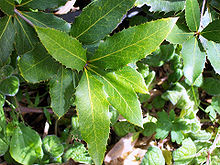Eidothea hardeniana
| Eidothea hardeniana | |
|---|---|
 |
|
| Nightcap Oak leaves at Royal Botanic Gardens, Sydney | |
| Scientific classification | |
| Kingdom: | Plantae |
| (unranked): | Angiosperms |
| (unranked): | Eudicots |
| Order: | Proteales |
| Family: | Proteaceae |
| Subfamily: | Proteoideae |
| Genus: | Eidothea |
| Species: | E. hardeniana |
| Binomial name | |
|
Eidothea hardeniana P.H.Weston & Kooyman |
|
Eidothea hardeniana, commonly named Nightcap Oak, is a species of trees up to 40 m (130 ft) tall, of the plant family Proteaceae, which botanist Robert Kooyman recognised as a new species only recently in 2000. The species has an official listing as critically endangered on the Australian Commonwealth EPBC Act and as Endangered on the NSW Threatened Species Act. The name hardeniana honours the botanist Gwen Harden. Phylogenetics studies now suggest it represents a basal branch of the Proteoid clade of the Proteaceae.
The trees are only known to grow naturally in a single creek catchment in warm temperate rainforest in the Nightcap Range, northern New South Wales, Australia. They grow naturally in relatively poor, acidic volcanic soils, in an area of a high rainfall. Only around 100 wild plants are known. Plants are in cultivation, including in the Royal Botanic Gardens, Sydney.
E. hardeniana trees have pale lichen covered bark typical of many species in the Warm Temperate Rainforests. Often a ring of coppice shoots surrounds the base of an adult tree, coppice and seedling leaves have spiny marginal teeth, while adult leaves have no teeth.
Flowers are cream in clusters and smell of aniseed.
Fruits are large and rounded with a yellow green skin and a hard nut inside. The walls of the nut are ribbed, a feature unique to this genus in the family. The seed has a white center and it probably contains poisonous cyanogenic compounds like some species of Macadamia. These toxins do not deter rodents from eating through the hard nut and devouring the seeds, limiting the regeneration of this plant.
un-opened buds
Flowers
Flowers
flower growing directly from the main stem
...
Wikipedia

